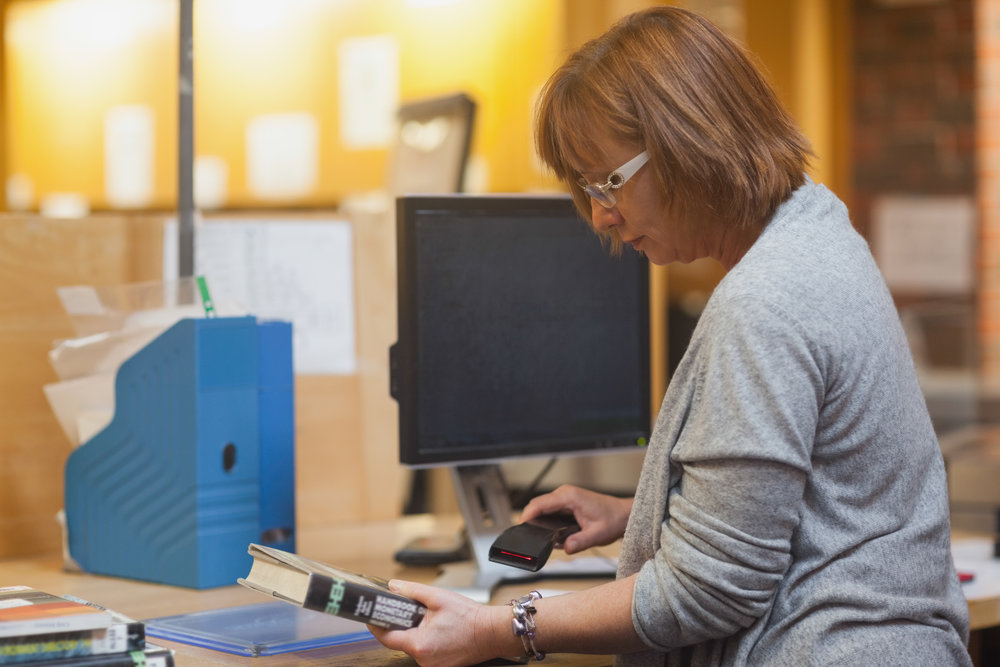Wasp Barcode Technologies: The Barcode Solution People
The Scanner Series: Barcode Scanners In Education
 As any teacher, administrator, or manager in an education setting knows, there is much more to education than simply putting students and educators in the same room.
As any teacher, administrator, or manager in an education setting knows, there is much more to education than simply putting students and educators in the same room.
Whether we’re talking middle schools or universities, most places of learning rely on an unexpectedly high number of expensive investments—fixed assets like IT equipment and tablets or laptops—to teach their students.
As a result, not only do schools systems spend millions on technology and assets for their students, but since most of those investments come from taxpayer dollars, they must also spend dozens of hours each year auditing themselves to ensure everything is accounted for.
That’s why we’re seeing more schools moving towards automated systems that reduce, if not outright eliminate, costly errors and losses.
Additionally, schools are increasingly moving into the digital age in all aspects of their daily routines. Even the time-honored system of saying “Here!” when doing roll call may be on its way out in favor of more efficient systems.

The source of these changes?
The barcode scanner.
In this ongoing series on how barcodes and the scanners that read them are changing the world we live in, today we’ll examine how the education space is no exception.
Making larger technological investments possible
As the world changes, schools are keeping up by using more and more technologically savvy devices, from iPad tablets to lightweight Chromebooks.
Schools are providing students with digital devices and entrusting them to take care of their new educational tools, which typically cost much more than textbooks or notebooks of years past.
In some cases, the vendors of these devices are doing their best to get their products into the hands of school administrators, and subsequently students. But even when a laptop costs less than $200 per student, as is the case with a Chromebook, that’s still a major investment for schools to make.
If for any reason a device goes missing, that’s a loss that the school or district (or, of course, the child) would find hard to swallow.
That’s part of the reason why schools are turning to systems that provide transparency and accountability for all parties—and barcode-based systems are typically the most affordable and flexible in that regard.
By attaching barcodes to all assets and investments, teachers and administrators can create a database that matches each student to their device, and ensures no manual errors will get in the way of a student not receiving their needed laptop, or of a teacher accounting for everything she handed out at the beginning of the year once the end rolls around.
Barcode scanners can instantly update all information rolls with the scan of a label, reporting back to the cloud that a student has returned their device or that an item has been checked out for the day (if the item in question is one shared by all students in the classroom, for example).
Using this system makes investing way more palatable and less risky for schools.
Reducing unnecessary time spent auditing with scanners
Money is an extremely important resource for educators. Another vital resource is time.
[Tweet "Money is an extremely important resource for educators."]
Every moment that a teacher spends working, but not working on their lesson plans, or with students who need extra help, or preparing for tests, is typically time wasted.
And yet, many case studies show that schools spend literal weeks out of the year conducting manual checks of their fixed assets. Untold hours are spent transferring information to and from spreadsheets, and extra staffing is often needed as a result.
On top of all that, it’s extremely rare for a manual audit to even be 100 percent accurate. Making mistakes on these kind of counts is simply human. So educators and administrators spend all that time just to not get things right.
Once the Gananda School District in upstate New York moved to a mobile asset tracking system, complete with barcode scanners, they saw a 75 percent reduction in staffing hours completing their physical inventory of assets; eliminated data entry errors; saw 99 percent tracking accuracy; saved over $3,500 annually performing summer inventory; and were able to turn in accurate, detailed audit reports.
That time is money. Reducing the time educators spend on non-education tasks is crucial to ensuring teachers don’t burn out, get bogged down, or distracts them from their main goals.

Ensuring no mistakes are made—not even in attendance
Any area where you can increase efficiency and save time is an area worth exploring. That’s why some schools are even looking to change the way they take attendance. And barcode scanners can help.
Schools can assign digital ID cards to students, who then get those IDs scanned whenever they enter and/or exit a classroom. By using WiFi or Bluetooth, classrooms can automatically generate daily barcodes that students need to scan, or have scanned, in order to prove their attendance. No more time wasted on roll call or grades getting docked by the odd mistake in manual attendance taking.
This solution works because it’s easy to do, works for any size group, prevents cheating or mistakes, and allows near-instant access to previous attendance records when necessary.
These barcode-based systems can also be used to control access to buildings or to certain designated areas such as laboratories.
Committing to the safety of all people and assets
Safety is on the minds of everyone in school settings these days. One of the great things about barcode-based systems is they create digital records of attendance and recent location that can be accessed from anywhere.
In the case of a crisis or emergency, responders and administrators can have a good idea of who was or is currently in a school building, and records can be used in the immediate aftermath of a problem to ensure everyone is safe and accounted for.
While the safety of items doesn’t come close to touching the importance of the safety of humans, it still can be mentioned that theft and loss will be greatly reduced in situations where a device has a barcode associated with it. When these items can easily be traced back to their point of origin and/or to whom is responsible for it, recovery and prevention are much easier to ensure.
Like in so many areas of our society, barcode scanners in schools are making it easier and more efficient to save time and money, as well as increase security and peace-of-mind. A simple push of a scanner’s trigger or button is easy, effective, and affordable. Expect to see more and more places of learning adopt this technology in one way or another soon.

 The source of these changes?
The source of these changes? 


